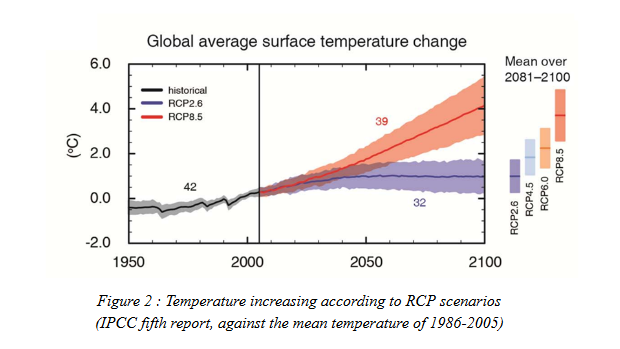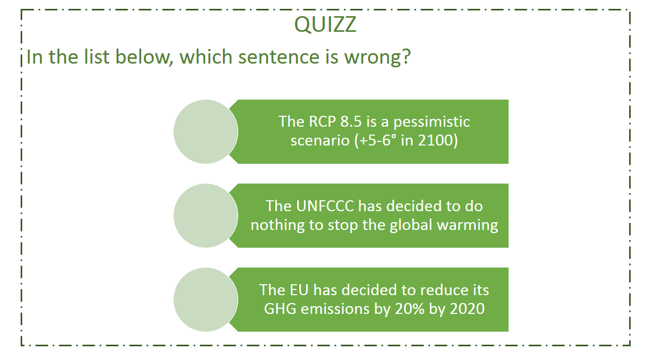- Home
- Clim'Foot
- Climate Change : introduction and key concepts
- How to react?
How to react?
Scenarios from the IPCC
The scientists are producing scenarios in order to assess the situation. Their current conclusion is called Representative Concentration Pathways (RCP): four scenarios modelling the GHG atmospheric concentration.
RCP 8.5 is the most pessimistic, and describes a world where nothing is done to reduce anthropogenic emissions.
RCP2.6 is the most optimistic, and describes a world where everything is done to reduce anthropogenic emissions, in order to steady the warming under +2° in 2100 against 1850.
With this scenarios, IPCC can calculate the amount of GHG the humanity can still emit before it is too late: it is called carbon budget. Thus, for each year, the humanity know how much GHG can be emitted. The humanity will have to be carbon-neutral between 2075 and 2100. Knowing that, each country can (and have to) work on reducing its GHG emissions.
International awareness
The United Nations Framework Convention on Climate Change (UNFCCC), born of the Rio Summit of 1992, targets the stabilization of greenhouse gas emissions of anthropogenic origin. It was reinforced by the adoption of the Kyoto Protocol in 1997 which sets an objective of reducing the emissions of 38 industrialized countries by 5.2% over the period 2008-2012, compared to emissions in 1990. The European Union, for its part, committed to reducing its emissions by 8%, an objective that has been achieved.
In addition, since 1 January 2005 a GHG emissions quota trading system has been in place in the EU, based on directive 2003/87/EC of 13 October 2003, but only very emitting activities are concerned by this system. Our energy consumption, especially from fossil sources, is in question.
The EU Climate & Energy package
In December 2008, under the French presidency of the European Union (EU), the European heads of state adopted the climate & energy package. Through this series of directives and regulations, Europe undertakes to reduce, by 2020, its global greenhouse gas emissions by 20% compared to 1990 levels. The EU plans to increase this objective to -30% if other industrialized nations accept doing the same.
To achieve this level of reduction, the EU needs to attain other objectives (20-20-20 measures) :
-
improving energy efficiency by 20% by 2020;
-
increasing to an average of 20% the proportion of renewable energies accounted for in energy consumption.
The climate & energy package also underpins the emissions quota trading scheme, extending it to all industrial emitters and to civil aviation (domestic flights and flights between countries covered by the ETS Directive), and developing the auctions market.
A new Climate & Energy package is currently being discussed in order to determine new energy efficiency ambitions in Europe for 2030.
As far as environmental accounting is concerned, the European Commission has launched a three-year trial whose main objective is to develop reference bases for sectors in Europe through application of general Product Environmental Footprint (PEF) and Organization Environmental Footprint (OEF) methods.
The trial also looks to test how environmental information is verified. To this end, the Commission has launched a bibliographical study aiming to identify and describe the most appropriate conformity systems for PEF or OEF declarations.
See the next page "The carbon accounting". Or return to the menu.


